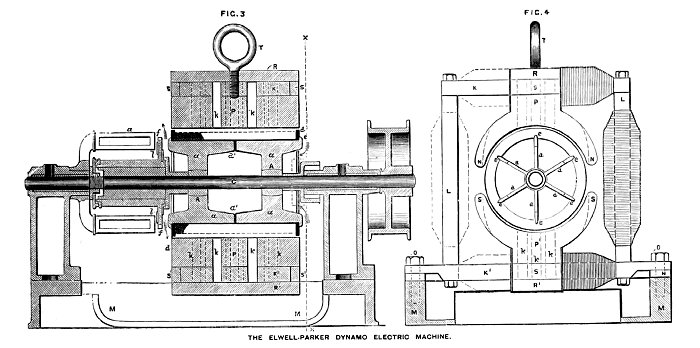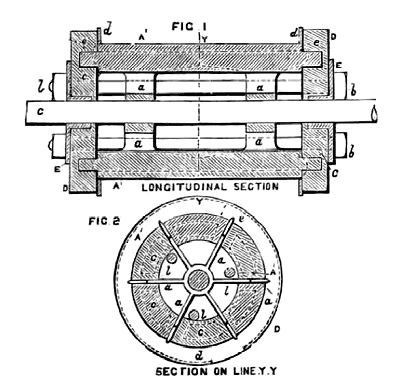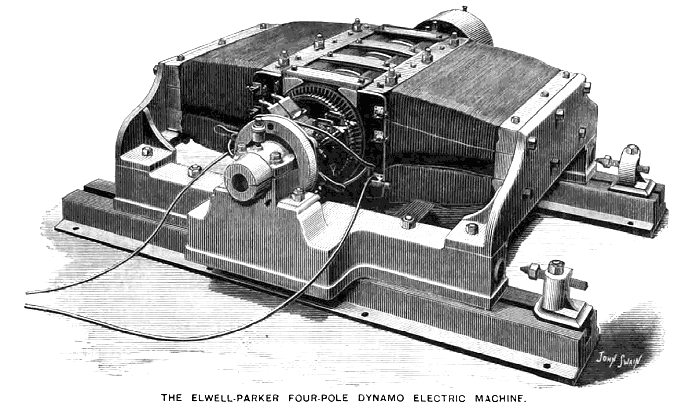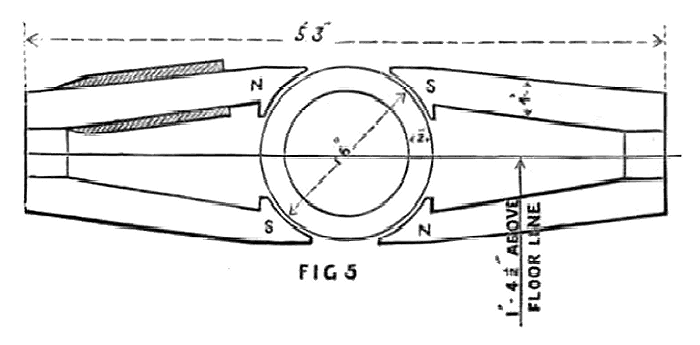|
Electical Engineering at
the Inventions Exhibition
Messrs. Elwell-Parker Limited, of
Wolverhampton, show a large display of their dynamos, ranging
from machines for an output of 1,500 watts up to 50,000 watts.
With exception of the large machine, which has four poles all
the others are of the Gramme type with two poles, and are now
being manufactured in almost every detail according to the
original patents taken out by Messrs. Elwell and Parker in 1883.
It is not often that we find the whole
process of manufacture of any machine covered by the original
specification. On the contrary, in most cases the first patent
is merely the starting point for the practical development of
the invention, and manufacturers find it necessary to continue
patenting details until the final shape taken by the invention
is, on the one hand, shorn of a good deal that was considered
most important at first, and, on the other hand, contains some
salient features which were not even hinted at in the final
patent.

Messrs. Elwell-Parker’s specification,
1883, No. 770 is an exception to this rule, and possesses,
therefore, considerable interest. It would be perfectly correct
if we were to describe their dynamos by simply quoting parts of
their original specification; but as this does not contain any
numerical data, we prefer to give the description in our own
words and to add such figures and practical information as, by
the courtesy of the firm, we are able to lay before our readers.
It might be said that the Elwell-Parker
dynamo was invented to order. The firm commenced their
electrical work by the manufacture of an improved form of Planté
accumulator; and as in the “forming” of the cells, dynamos were
required, they used at first, what machines they could obtain in
the market. This was two years ago, and our electrical readers
who have had experience in similar work will not be surprised to
hear that none of the machines obtainable at that period could
satisfactorily be used for charging accumulators. Sparking at
the brushes, worn out commutators, waste of power, reversal of
polarity, burned up armatures, and other like evils were the
order of the day. All this has been changed since then, and
perfectly satisfactory machines can now be obtained from dozens
of makers; but then it was not so, and Messrs. Elwell-Parker
resolved to satisfy their wants by making their own machines.
The first machine was finished in October,
1883, and has been used continually since that time in the
company’s works, partly for lighting, and partly for charging.
Its armature can be described as a compromise between the
ordinary Gramme ring and the Bűrgin hexagon. It shares with the
former the circular shape and the winding which completely
covers the external surface of the core, and at the same time it
has the mechanical advantage of the latter, the way the core is
supported on metal arms. In the Bűrgin machine the arms are
forced into the ring after the same is wound, and they take a
bearing in the corners of the hexagon.
Since there can only be six distinct coils
on each ring, it is necessary to employ a number of these rings
so as to get an even current and to avoid sparking. This limits
the width of each ring to about 2 to 3 inches. Now in the Elwell-Parker
armature any desired number of coils may be wound on to the core
to ensure an even current without the necessity of employing
several rings on the same spindle, and the width of the ring is
not limited by any other consideration but that of obtaining the
desired output.
Since the forcing of the arms into a
circular ring would necessarily deform the ring, Messrs. Elwell-Parker
have introduced the improvement of coiling the wire direct over
the arms, and not into a dummy as was done by Bűrgin. They
insert segments of wood between the arms, so as to preserve to
the ring a true circular shape, although the wire be coiled with
a considerable amount of tension. We illustrate in Figs. 1 and 2
the method adopted for coiling the core. The supporting arms
a a are keyed to the spindle C, and after having been
insulated with tape and fibre, the latter to prevent metallic
contact between the core and the arms, the wood blocks AI
are inserted and held in place by discs DD, into which
they are morticed. Three bolts b keep the whole frame
together. To prevent the small lugs or projections e
coming in metallic contact with the iron of the core, washers
d d of vulcanised fibre are placed one at each end, and the
space between them is now completely filled with iron wire
coiled on as evenly as possible. In the process of coiling a
bituminous compound is applied, which is intended to insulate to
a certain extent the wires from each other.
 |
|
In our article of last week we had
occasion to speak of the value of that kind of
insulation, and need not reopen the subject. The
application of bitumen has, however, this important
advantage, that it renders the core more like a solid
mass of metal, which can be turned up true in the lathe.
In fact, that is what Messrs. Elwell and Parker do.
After a few layers of wire are
coiled on, the surface is tested, and if found out of
truth a cut is taken over it. We need hardly mention
that the depth of a cut never equals the diameter of the
wire, and usually is only a fraction of it. A few more
layers are then coiled, and if necessary a cut is taken
gain, and so on until the core is completed to the right
radial depth. In this way a true cylindrical core is
obtained. |
After removing the blocks of wood and
insulating the core, it is wound with double silk covered copper
wire in the usual Gramme fashion, but only one layer of wire is
used on the outside of the core; and this rule is not departed
from even if the electro-motive force required be 1,000 volts.
No such high tension machine is, however, shown at the
Exhibition, the maximum electro-motive force reached by any of
the exhibited machines being 300 volts. This is a 6,000 watt
machine used in conjunction with B.T.K. accumulators for
lighting the East Quadrant. It has already been remarked in a
previous article that most of the modern dynamos contain only
one layer of wire on the armature; the Crompton,
Edison-Hopkinson, Mather and Platt, and several other machines
are constructed in this way; but Messrs. Elwell-Parker have
pushed the principal to the utmost limit by making this layer
exceptionally thin; in other words by allowing a high density of
current in their armature coils.
Most makers regard 3,000 amperes per square
inch of conductor a sufficient strain, but in the dynamos under
consideration the density is frequently as high as 6,000
amperes. Roughly speaking we may say that the thickness of the
single layer in the Elwell-Parker machine is about one half of
that found in other dynamos, and in this sense the firm have
pushed the single layer principle further than other maker. They
maintain that by making the core of small radial depth, so that
even the inner coils do not completely fill two layers, the
carrying capacity of the wire is considerably increased.
The interior of the core is not ventilated,
but by a peculiar arrangement on the commutator a current of air
is kept flowing into the cavity of the armature at the pulley
end, and out between the wires which join the armature to the
commutator. This serves to cool the inner wires whilst the outer
turns are kept cool by being whirled through the surrounding air
at considerable speed. How far this object is obtained we are
unable to say; the point can only be settled by the actual
experiment of working a machine with a full current, say, for
fifty hours continuously. It should be remembered that doubling
the density of current means quadrupling the heat generated, and
that would require four times the cooling power. If Messrs.
Elwell and Parker are able to do this we see no reason why other
makers should not do the same by the application of a fan or
other special device, and thus double the output of their
machines. But we must return to the general description of the
Elwell-Parker dynamo.
In Figs. 3 and 4 we illustrate this machine
by a longitudinal section and an end view. The supporting arms
or “spiders” are keyed to the spindle C by the hubs A
A. Part only of the core is shown, and the armature coils
are left out for clearness of illustration. The dark lines
represent the insulation between the arms and core. No special
description of the commutator is required, as its construction
is clearly shown in our drawing. We must mention however, that
the lugs are considerably extended, forming a large disc, to the
front end of which is attached a fibre disc l, and this
arrangement serves partly to prevent copper dust from being
drawn into the armature, and partly acts as a fan by which a
current of air is sent through the armature in the direction of
the arrows.
The field magnets consist of flat wrought
iron slabs K L bolted together in the shape of a
rectangle, with cast iron pole pieces pinned on in the middle of
the top and bottom slabs. A large number of Tins K K is
used, these pins being driven tightly into holes bored out in
the pole pieces so as to be in close contact with the metal. By
this arrangement it is intended to obtain the magnetic
conductivity of wrought iron whilst still retaining the cheaper
material, viz., cast iron for the bulk of the pole pieces. In
small machines the frame M M is made of Parker’s metal,
but in larger machines it is made of cut iron, and packing
pieces of non-magnetic metal are inserted between frame and
field magnets.
It is of interest to note that the
thickness of these pieces need not be very great; at any rate
much less than would be required in an Edison machine of equal
size. In the latter the pole pieces themselves have to be kept
off the frame by non magnetic packing, and since the free
magnetism is greatest at the poles the magnetic insulation must
be correspondingly high. In the Elwell-Parker machine, however,
the two portions of the field magnets which come nearest the
frame both belong to the lower pole, and are therefore
magnetically at a comparatively low difference of potential.
Even if the packing were omitted the machine would still
continue to work. The only effect would be a very slight drop of
electromotive force due to the partial muffling of the two lower
half coils by direct contact with the frame. The rest of the
magnetic circuit would, however, not be altered. The arrangement
of magnets adopted by Messrs. Elwell-Parker is certainly very
compact but we think that it might be improved by keeping the
vertical magnets a greater distance from the polar extensions
N S. As is well known, magnetism is always densest at the
corners, and a considerable number of lines of force must be
wasted by leakage from those corners to the core of the magnet.
Some slight improvement might also be effected by shaping the
extensions as shown in dotted lines.

The first armature made by the
firm is exhibited in the East Arcade, and is a very creditable
piece of workmanship. Although it has been continuously at work
from October, 1883, until the opening of the Exhibition, and has
been used hard, it does not show any signs of this except a
slight bulging of the external wires, which is doubtless due to
the fact that they are held in place by friction only, and at
some time or other, probably when giving an excess of current,
have slightly shifted on the core. The core is 7 inches in
diameter, 9inches long, and l inch thick. The effective area of
iron is therefore: π/4 x 9 x 1 = 7.07 square inches. The field
magnets are wrought iron slabs 8 inches by 1¼ inches, having a
cross sectional area of 10 square inches, or about 30 percent in
excess of that of the armature.
The latter is wound with 225
turns of 0.83 inch wire, total length about 130 yards. At a
speed of 1,600 revolutions per minute the external electromotive
force is 60 volts, being at the rate of 2.16 yards per volt. The
field magnets are shunt wound, and contain 46 ohms of 0.058
wire. This corresponds to about 4,700 yards, and since the mean
perimeter of magnet coils can be taken as about 0.83 yards, we
find the total number of turns = 4,700 : 0.83 = 5,660. The
exciting power on one half of the machine is therefore 2830 x
current through the shunt wire. The latter is 60 : 46 = 1.3
amperes and the exciting power 3,680 ampere turns. This is a
remarkably low figure, and is probably due to the fact that the
clearance between the armature and pole pieces has by careful
workmanship been reduced to the very lowest possible limit.
From the figures given above
we calculate the electrical efficiency of the machine as
follows: resistance of the armature, 0.152 ohms; with an
external current of 0.65 amperes, the current through the
armature is 66.3, and the loss of pressure about 10 volts;
internal energy, 70 x 66.3 = 4,640 watts; external energy, 60 x
65 = 3,900 watts; efficiency, 86 percent. The resistance of the
armature is calculated at ordinary temperature, but with a
density of 6,150 amperes, which corresponds to 65 amperes
output, and it is probable that the temperature of the wire will
rise considerably, increasing at the same time the resistance of
the armature. This would of course slightly lower the
efficiency. There are 6.8 lb. of copper on the armature, and 142
lb. on the magnets; total 148.8 lb. With a speed of 1,600
revolutions the output is therefore at the rate of 26.2 watts
per pound of copper. With our standard speed of 1,000
revolutions the output would be at the rate of 16.3 watts per
pound of copper.
A word of explanation is necessary as
regards the number of yards of armature conductor per external
volt. Some makers, and amongst them Messrs. Elwell-Parker argue
that since at any moment both halves of the armature lying on
either side of the diameter of commutation are coupled parallel,
the electromotive force is produced on one half of the wire, and
it is therefore right to take only one half of the total length
when figuring out the number of yards per volt.
This argument is perfectly logical, and can
be upheld on scientific grounds. But since an armature only half
wound with wire is practically useless, we prefer to adhere to
our plan of always counting the whole of the wire when the
machine has two poles. With a four-pole machine the case is
different. Here we are quite justified in counting only half the
total wire, because it is practically possible, though not
advisable, to work the machine by allowing only one-half the
armature to be active. The current will thereby be diminished to
half its normal strength, but the electromotive force will
remain the same. Similarly in a six-pole machine, we would only
count one third of the total length of wire coiled on the
armature, and so on.
Messrs. Elwell-Parker exhibit a very
interesting four pole machine, which we illustrate in the
annexed engraving. The armature is constructed precisely as that
of their first machine described above, but is of much larger
dimensions. The core is 16 inches in diameter, 36 inches long,
and 2 inches deep. It is wound with 186 turns of double 0.120
wire, the perimeter of each turn being 2.14 yards. This gives a
total of 398 yards of double conductor. At a speed of 450
revolutions per minute, the external electromotive force is 110
volts, being at the rate of 1.81 yards per volt.

We give in Fig. 5 a transverse section
through armature and magnets, omitting, however, all
constructive details, as our sketch is only intended to show the
grouping of the, pole pieces. To each side of the armature is
fixed a complete horseshoe magnet, which is supported at the
yoke in the cast iron framework, as will be seen from our
perspective illustration, and at the poles by gunmetal bolts
tapped into a central girder. The distance between the girder
and any part of the magnet is at least twelve times the
clearance between the surface of the armature core and the face
of the pole piece. The exciting coils, of which we only show
one, are 17 inches long, and each contain 2 cwt. of 0.058 wire
having a resistance of 72 ohms. The four arms are coupled
parallel. Each contains about 3,430 turns, and is traversed by
an exciting current of 1.53 amperes. The exciting power in one
of the magnets is therefore 2 x 3430 x 1.53= 10,500 ampere
turns.
The resistance of the armature, cold, is
0.0278 ohms. We must mention that this figure is not from
measurement, but is obtained by simply dividing the resistance
of 398 yards of double 0.120 wire by l6. The effective area of
iron in the armature is 56.4 square inches, whilst the cross
sectional area of the magnets, which are slabs 4 inches by 32
inches is 128 square inches, or more than double the former
figure. This is, however, perfectly correct and as it should be,
for with the arrangement chosen each magnet must supply
sufficient lines for filling twice the area of the armature
core; and if the lines shall not be throttled in any part of the
magnetic circuit, the area of the magnet cores must be at least
twice that of the armature core.
The machine is classified as a 50 unit
dynamo; electromotive force, 110 volts; current, 460 amperes;
current in shunt coils, 6.12 amperes; loss of pressure in
armature,13 volts; internal electrical energy, 466.12 x 123 =
57,200; external energy, 50,600; efficiency, 88.3 percent. The
density of current is 5,150 amperes in the armature coils, and
580 amperes in the shunt coils. The weight of copper used is
104lb. in armature, 896lb. in field; total l,000lb. At 450
revolutions the output is therefore 50.6 watts per pound of
copper; at our standard speed of 1,000 revolutions per minute it
would be 112 watts per pound of copper.
If the coils in the field magnets be joined
up in such way as to make both poles above the centre line N and
both below it S, the machine will work like any ordinary
two-polar dynamo. Two brushes only will in this case be
employed. Messrs. Elwell-Parker have made that experiment, and
have found that the electromotive force is thereby only
increased by about 30 percent, whilst, of course, the current is
halved. On purely theoretical grounds we would expect that the
electromotive force should be doubled; but in practice a point
of saturation, as regards the density of lines in the armature
core, is soon reached, and that prevents the full advantage
being obtained from the two-polar arrangement. To make our
meaning, clear, let us assume for sake of argument that in the
four-polar arrangement there are 112,000 lines emanating from
each polar surface. We choose this figure simply by way of
illustration, as it is a convenient multiple of the area of
armature core.
Through each square inch of it there will,
therefore, be 1,000 lines. In order that the electromotive force
may be doubled by the two-polar arrangement, the total number of
lines emanating from the four poles must remain the same, and to
make this possible the density of lines would have to be 2,000
per square inch of core. This is probably more than the core can
carry; or, in other words saturation sets in and prevents the
full number of lines from being created.
Messrs. Elwell-Parker have supplied two
dynamos like the one described to the Blackpool Electric Tramway
Company, as well as seven motors for propelling the cars. A
similar motor is exhibited in Mr. Holroyd Smith’s car on the
South Promenade. We hope to give a full description of this
system of electrical propulsion shortly, and for the present
must content ourselves to lay before our readers a few data
regarding the motor only. It is shunt wound, and intended to
work with a potential of 200 volts. The current is supplied by
an Elwell-Parker dynamo, driven by a high speed engine also made
by that firm.
With a current of 30 amperes through the
armature of the motor, it exerts a statical torque of 56lb. on a
radius of 16 inches. We can, with sufficient approximation,
assume that the dynamic torque is the same, the field magnets
being shunt wound and the strength of field therefore
independent of the current through the armature, and in that
case the motor would give off about 8 horsepower at a speed of
600 revolutions per minute. The resistance of the armature is
0.75 ohms, that of the field magnets 200 ohms. The motor weighs
6 cwt. Its field magnets resemble somewhat those of a Siemens
machine, which form has been adopted in order to be able to get
the motor into the confined space under the floor of the car.
In all there are eleven dynamos and one
motor exhibited by Messrs. Elwell-Parker; their list is as
follows: one 50,000 watt machine, driven by Tower engine, and
lighting the Club dining room; one 20,000 watt machine as a
reserve to the above; one 12,000 watt machine for charging
accumulators, lighting the Royal Pavilion; one 6,000 watt
machine, charging B. T. K. accumulators, for lighting the East
Quadrant; one 6,000 watt machine, driven by Willans' engine, and
lighting the Subway; one 6,000 watt generator, driven by Elwell-Parker
engine, and supplying current to electric tramway; one 3,000
watt machine, driven direct by three-cylinder Elwell-Parker
engine, intended for train lighting; one 3,000 watt machine,
driven by 3½ horsepower Otto gas engine, charging 26 cells at
Mr. Taylor Smith's stand; one 3,000 watt machine, driven by
Beachy gas engine, and lighting Messrs. Woodhouse and Rawson’s
stand in East Arcade; one 1,500 watt machine, driven by Gramme
motor; one 6 horsepower motor, driving electric tramcar. |